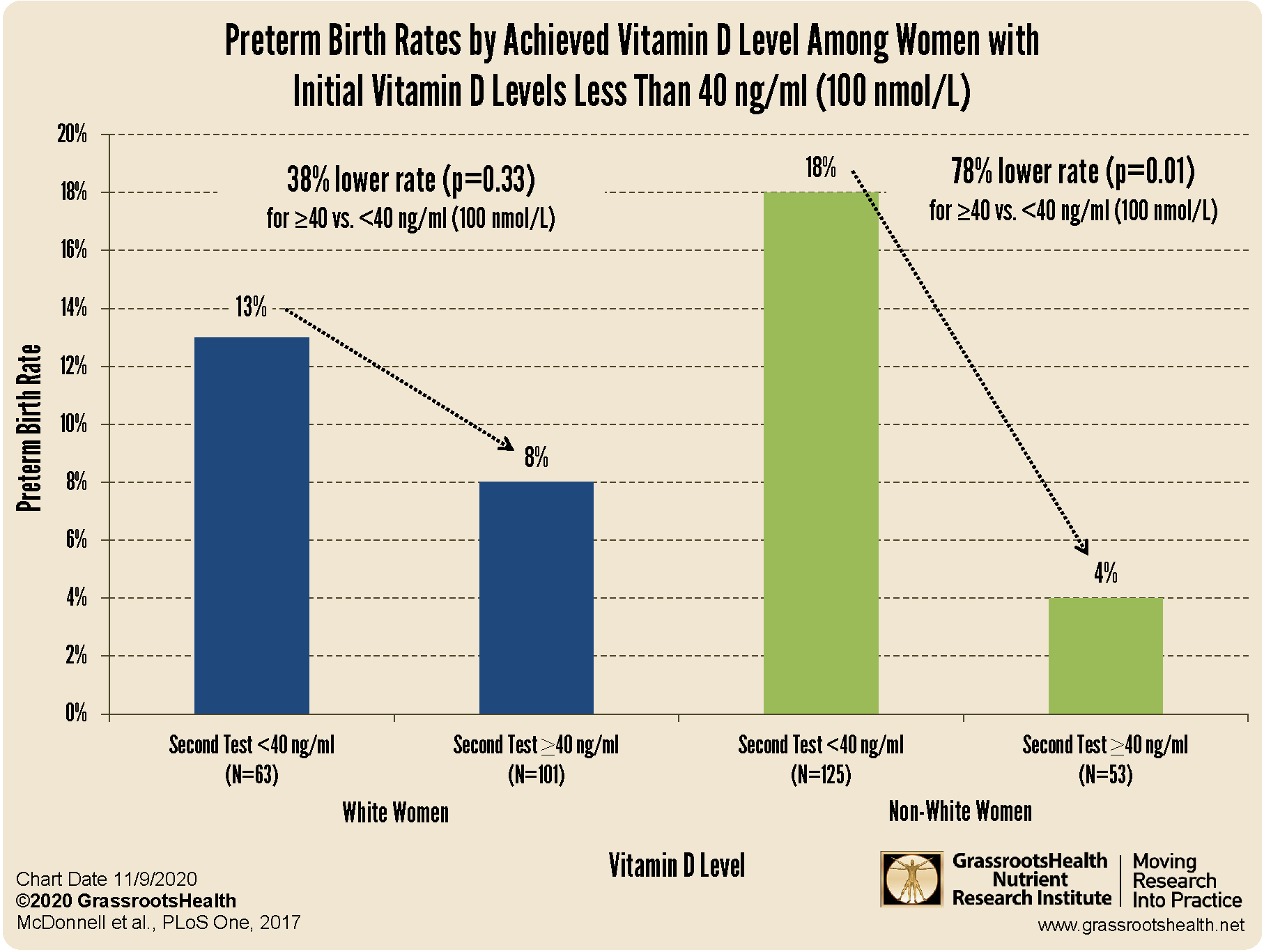Published on April 11, 2022
Black Maternal Health Week – A greatest impact on maternal and infant health could be made simply by addressing vitamin D deficiency among Blacks!
Key Points
- Approximately 68% of Black women have vitamin D levels below 20 ng/ml (50 nmol/L) and at these levels, would be expected to have a 20% preterm birth rate
- Among women whose initial vitamin D level was less than 40 ng/ml, the preterm birth rate was 38% lower for white women and 78% lower for non-white women if they raised their level to at least 40 ng/ml prior to giving birth vs. those who did not
- Women with vitamin D levels at or above 40 ng/ml compared to women with levels less than 20 ng/ml had a 65% lower risk of preterm birth among white women and a 68% lower risk among non-white women
- There was NO difference in preterm birth rates (what was measured in the study) by ethnicity if vitamin D levels were equal; we can erase disparity in preterm birth caused by vitamin D deficiency, according to this analysis, by bringing everyone’s vitamin D levels to at least 40 ng/ml

The month of April is recognized as National Minority Health Month in the United States, and today is the first day of Black Maternal Health Week (BMHW), which takes place every year from April 11-17.
Last week, we reviewed data showing how increasing vitamin D levels to the 40-60 ng/ml (100-150 nmol/L) range could virtually eliminate racial health disparities seen among those with darker skin. It is an unfortunate reality that Blacks have the lowest levels of vitamin D, with a 15-20 fold higher prevalence of severe vitamin D deficiency. According to NHANES data, approximately 68% of Black women have vitamin D levels below 20 ng/ml (50 nmol/L) and at these levels, would be expected to have a 20% preterm birth rate; this is a problem that must be addressed for mothers within these groups of darker skin!
Below, we share our own research showing the gap in preterm birth outcomes between white and black mothers – a gap that virtually disappears when vitamin D deficiency is corrected.
How do race and vitamin D levels affect the risk of having a preterm baby?
We have previously summarized the main results from a published GrassrootsHealth study showing a 62% lower risk of preterm birth for women with vitamin D levels at or above 40 ng/ml (100 nmol/L) compared to women with levels less than 20 ng/ml. Below, we look at another analysis from that paper which assessed the association between vitamin D and preterm birth risk for white and non-white women. This was important to look at due to the racial and ethnic differences in preterm birth rates, with Black women having higher rates compared to other groups.
Among the women in the study (N=1,064), 10% of white women and 15% of non-white women had a preterm birth. Black women accounted for a majority (69%) of the non-white births and had a 19% preterm birth rate. For those with vitamin D levels at or above 40 ng/ml compared to women with levels less than 20 ng/ml, there was a 65% lower risk of preterm birth among white women (p=0.03) and a 68% lower risk among non-white women (p=0.008). The similar decreased risk suggests that improvements in vitamin D status may decrease the disparity in preterm birth rates between racial/ethnic groups.
As illustrated in the chart above, among women whose initial vitamin D level was less than 40 ng/ml, the preterm birth rate was 38% lower among white women (p=0.33) and 78% lower among non-white women (p=0.01) for those who raised their level to at least 40 ng/ml prior to giving birth vs. those who did not.
This indicates that improving the vitamin D status of non-white women, who are more likely to have low vitamin D levels, could dramatically decrease racial disparities in preterm birth rates.
Getting Technical: Vitamin D Level Alone Makes a Difference
The most telling part of this analysis comes toward the end of the results section of the paper:
Differences by race/ethnicity were not statistically significant when 25(OH)D concentration was included as a covariate in multivariable regression analysis.
What Does This Mean?
When statisticians crunch data, to sort out findings from a study, there are times when they want to make sure that the finding wasn’t due to a separate variable. For example, many times in vitamin D trials, they account for BMI, which is used as a marker for obesity.
Multivariable regression testing is a way to look at many variables within your trial and see how they affect each other. So, in the BMI example, did vitamin D lower all heart disease? Or only for those that had a BMI < 25? We won’t get into the math to make this computation happen, let’s just say the statisticians know their numbers.
So, the statement above is really the key to disparity and the plausible conclusion that vitamin D levels in recommended ranges (40-60 ng/ml) could level the playing field for all races.
To a statistician this statement means…
there was NO difference in preterm birth rates (what was measured in the study) by ethnicity if vitamin D levels were equal.
Now, we KNOW that there is a huge disparity in preterm birth rates among racial groups. And, as you can now see, we can erase disparity in preterm birth caused by vitamin D deficiency, according to this analysis, by bringing everyone’s vitamin D levels to at least 40 ng/ml (100 nmol/L).
One Simple Change Makes a BIG Difference
It should be made clear to ALL that vitamin D alone has the potential to make a big difference in health outcomes, especially for black individuals. Learn why are blacks so deficient in vitamin D in the first place and what can be done to address this issue for all!
How Much Vitamin D Do You Need? Find Out with Your Home Test!
 Having and maintaining healthy vitamin D levels and other nutrient levels can help improve your health now and for your future. Choose which additional nutrients to measure, such as your omega-3s and essential minerals including magnesium and zinc, by creating your custom home test kit today. Take steps to improve the status of each of these measurements to benefit your overall health. With measurement you can then determine how much is needed and steps to achieve your goals. You can also track your own intakes, symptoms and results to see what works best for YOU.
Having and maintaining healthy vitamin D levels and other nutrient levels can help improve your health now and for your future. Choose which additional nutrients to measure, such as your omega-3s and essential minerals including magnesium and zinc, by creating your custom home test kit today. Take steps to improve the status of each of these measurements to benefit your overall health. With measurement you can then determine how much is needed and steps to achieve your goals. You can also track your own intakes, symptoms and results to see what works best for YOU.
Enroll in D*action and Test Your Levels Today!






